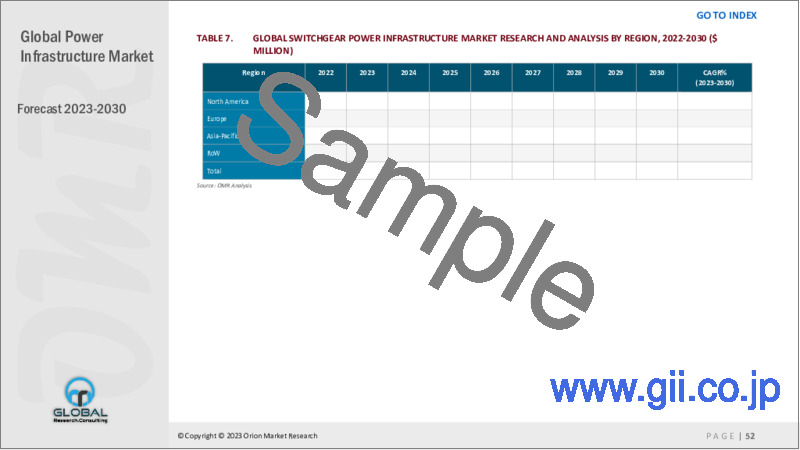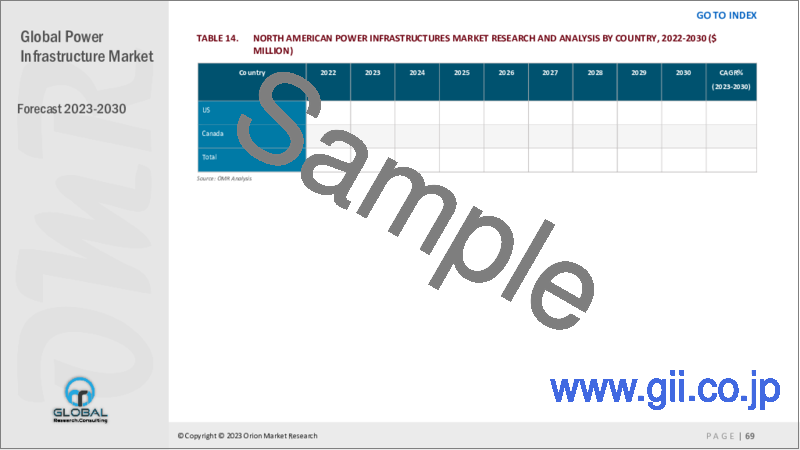|
|
市場調査レポート
商品コード
1292910
電力インフラの世界市場2023-2030Global Power Infrastructure Market 2023-2030 |
||||||
カスタマイズ可能
|
|||||||
| 電力インフラの世界市場2023-2030 |
|
出版日: 2023年05月20日
発行: Orion Market Research
ページ情報: 英文 185 Pages
納期: 2~3営業日
|
- 全表示
- 概要
- 図表
- 目次
世界の電力インフラ市場は、予測期間中にCAGR 8.04%の大幅な成長が見込まれています。電力インフラに対する需要は、いくつかの理由によって増加しています。人口増加、都市化、工業化はすべて電力需要の増加につながっています。世界人口の増加はより多くのエネルギーを必要とし、より多くの人々が都市に移動するにつれて、電力需要が増加します。また、製造業、建設業、テクノロジー産業などの急速な成長も電力需要の増加につながっています。さらに、再生可能エネルギーへの移行により、風力タービンやソーラーパネル、エネルギー貯蔵システムや配電インフラなど、新しい電力インフラの必要性が高まっています。また、多くの国では、信頼性が高く効率的な電力供給を確保するために、老朽化した電力インフラのアップグレードや交換が必要となっています。
セグメント別の見通し
世界の電力インフラ市場では産業用サブセグメントが圧倒的シェアを占める
市場は用途別に、産業用電力、商業用電力、住宅用電力に細分化されます。このうち、産業部門が市場で大きなシェアを占めると予想されます。産業部門は通常、商業部門や住宅部門に比べて最も多くの電力を必要とします。産業部門には、製造、建設、鉱業、その他、機械、設備、生産工程に大量のエネルギーを必要とする産業プロセスが含まれます。これらの産業は年中無休で操業していることが多く、操業を維持するために安定した信頼性の高い電力供給を必要とするため、大量のエネルギーを消費することになります。さらに、国際エネルギー機関(IEA)が発表した2020年の世界の電力消費に関する報告書では、産業部門が世界の電力消費の28%を占めるとされています。これは、2020年に世界の産業部門が消費する電力が約23,420TWhであることを意味します。
地域別展望
アジア太平洋地域が世界の電力インフラ市場を独占する見通し
電力インフラは、いくつかの理由からアジア太平洋地域で成長しています。同地域は急速な経済成長を遂げており、それが電力需要の増加につながっています。さらに、人口の増加が電力需要の増加に寄与しています。Worldometerの2023年のデータによると、アジア太平洋地域の人口は合計で47億8,000万人を超えます。この地域の市場成長を支えているもう一つの要因は、産業活動の活発化です。例えば、中国国家統計局は、2021年8月の中国の工業生産が前年同月比8.3%増となったと報告しています。
また、この地域は再生可能エネルギー発電、特に太陽光発電、風力発電、水力発電などの潜在力が大きいです。政府と民間投資家が化石燃料からの脱却と温室効果ガス排出量の削減を目指すなか、この地域では再生可能エネルギー・インフラの開発に注目が集まっています。アジア太平洋地域の多くの政府は、新しい電力インフラ、特に再生可能エネルギーの開発を奨励する政策やインセンティブを実施しています。例えば、中国やインドなど、この地域の一部の国では、電力会社に一定割合の電力を再生可能エネルギーで発電することを義務付ける再生可能エネルギー・ポートフォリオ基準(RPS)政策を実施しています。RPS政策は、需要を増加させ、新たなインフラへの投資を促進することによって、再生可能エネルギー市場の形成に貢献することができます。
目次
第1章 レポート概要
業界の現状分析と成長ポテンシャルの展望
- 調査方法とツール
- 市場内訳
- セグメント別
- 地域別
第2章 市場概要と洞察
- 調査範囲
- アナリストの洞察と現在の市場動向
- 主な調査結果
- 推奨事項
- 結論
第3章 競合情勢
- 主要企業分析
- 概要
- 財務分析
- SWOT分析
- 最近の動向
- 主要戦略分析
第4章 市場セグメンテーション
- 電力インフラの世界市場:タイプ別
- 変圧器
- 開閉装置
- 変電所
- 電力インフラの世界市場:用途別
- 産業用電力
- 商業用電力
- 住宅用電力
第5章 地域分析
- 北米
- 米国
- カナダ
- 欧州
- 英国
- ドイツ
- イタリア
- スペイン
- フランス
- その他欧州
- アジア太平洋
- 中国
- インド
- 日本
- 韓国
- その他アジア太平洋地域
- 世界のその他の地域
第6章 企業プロファイル
- ABB
- Adani Transmission Ltd.
- Alstom
- Eaton Corp.
- General Electric
- Hitachi ABB Power Grids
- Johnson Electric Coil Co.
- MCI Transformer Corp.
- Mitsubishi Electric
- Muskaan Power Infrastructure Ltd.
- Prism Power Group
- Schneider Electric
- Siemens Energy
- Toshiba Energy Systems & Solutions Corp.
- Triad Magnetics
- VRT Power
LIST OF TABLES
- 1.GLOBAL POWER INFRASTRUCTURE MARKET RESEARCH AND ANALYSIS BY TYPE, 2022-2030($ MILLION)
- 2.GLOBAL TRANSFORMERS POWER INFRASTRUCTURE MARKET RESEARCH AND ANALYSIS BY REGION, 2022-2030($ MILLION)
- 3.GLOBAL SWITCHGEAR POWER INFRASTRUCTURE MARKET RESEARCH AND ANALYSIS BY REGION, 2022-2030($ MILLION)
- 4.GLOBAL SUBSTATIONS POWER INFRASTRUCTURE MARKET RESEARCH AND ANALYSIS BY REGION, 2022-2030($ MILLION)
- 5.GLOBAL POWER INFRASTRUCTURE MARKET RESEARCH AND ANALYSIS BY APPLICATION, 2022-2030($ MILLION)
- 6.GLOBAL POWER INFRASTRUCTURE FOR INDUSTRIAL MARKET RESEARCH AND ANALYSIS BY REGION, 2022-2030($ MILLION)
- 7.GLOBAL POWER INFRASTRUCTURE FOR COMMERCIAL MARKET RESEARCH AND ANALYSIS BY REGION, 2022-2030($ MILLION)
- 8.GLOBAL POWER INFRASTRUCTURE FOR RESIDENTIAL MARKET RESEARCH AND ANALYSIS BY REGION, 2022-2030($ MILLION)
- 9.GLOBAL POWER INFRASTRUCTURE MARKET RESEARCH AND ANALYSIS BY REGION, 2022-2030($ MILLION)
- 10.NORTH AMERICAN POWER INFRASTRUCTURE MARKET RESEARCH AND ANALYSIS BY COUNTRY, 2022-2030($ MILLION)
- 11.NORTH AMERICAN POWER INFRASTRUCTURE MARKET RESEARCH AND ANALYSIS BY TYPE, 2022-2030($ MILLION)
- 12.NORTH AMERICAN POWER INFRASTRUCTURE MARKET RESEARCH AND ANALYSIS BY APPLICATION, 2022-2030($ MILLION)
- 13.EUROPEAN POWER INFRASTRUCTURE MARKET RESEARCH AND ANALYSIS BY COUNTRY, 2022-2030($ MILLION)
- 14.EUROPEAN POWER INFRASTRUCTURE MARKET RESEARCH AND ANALYSIS BY TYPE, 2022-2030($ MILLION)
- 15.EUROPEAN POWER INFRASTRUCTURE MARKET RESEARCH AND ANALYSIS BY APPLICATIO, 2022-2030($ MILLION)
- 16.ASIA-PACIFIC POWER INFRASTRUCTURE MARKET RESEARCH AND ANALYSIS BY COUNTRY, 2022-2030($ MILLION)
- 17.ASIA-PACIFIC POWER INFRASTRUCTURE MARKET RESEARCH AND ANALYSIS BY TYPE, 2022-2030($ MILLION)
- 18.ASIA-PACIFIC POWER INFRASTRUCTURE MARKET RESEARCH AND ANALYSIS BY APPLICATION, 2022-2030($ MILLION)
- 19.REST OF THE WORLD POWER INFRASTRUCTURE MARKET RESEARCH AND ANALYSIS BY COUNTRY, 2022-2030($ MILLION)
- 20.REST OF THE WORLD POWER INFRASTRUCTURE MARKET RESEARCH AND ANALYSIS BY TYPE, 2022-2030($ MILLION)
- 21.REST OF THE WORLD POWER INFRASTRUCTURE MARKET RESEARCH AND ANALYSIS BY APPLICATION, 2022-2030($ MILLION)
LIST OF FIGURES
- 1.GLOBAL POWER INFRASTRUCTURE MARKET RESEARCH AND ANALYSIS BY TYPE, 2022 VS 2030 (%)
- 2.GLOBAL TRANSFORMERS POWER INFRASTRUCTURE MARKET RESEARCH AND ANALYSIS BY REGION, 2022 VS 2030 (%)
- 3.GLOBAL SWITCHGEAR POWER INFRASTRUCTURE MARKET RESEARCH AND ANALYSIS BY REGION, 2022 VS 2030 (%)
- 4.GLOBAL SUBSTATIONS POWER INFRASTRUCTURE MARKET RESEARCH AND ANALYSIS BY REGION, 2022 VS 2030 (%)
- 5.GLOBAL POWER INFRASTRUCTURE MARKET RESEARCH AND ANALYSIS BY APPLICATION, 2022 VS 2030 (%)
- 6.GLOBAL POWER INFRASTRUCTURE FOR INDUSTRIAL MARKET RESEARCH AND ANALYSIS BY REGION, 2022 VS 2030 (%)
- 7.GLOBAL POWER INFRASTRUCTURE FOR COMMERCIAL MARKET RESEARCH AND ANALYSIS BY REGION, 2022 VS 2030 (%)
- 8.GLOBAL POWER INFRASTRUCTURE FOR RESIDENTIAL MARKET RESEARCH AND ANALYSIS BY REGION, 2022 VS 2030 (%)
- 9.GLOBAL POWER INFRASTRUCTURE MARKET SHARE BY REGION, 2022 VS 2030 (%)
- 10.US POWER INFRASTRUCTURE MARKET SIZE, 2022-2030($ MILLION)
- 11.CANADA POWER INFRASTRUCTURE MARKET SIZE, 2022-2030($ MILLION)
- 12.UK POWER INFRASTRUCTURE MARKET SIZE, 2022-2030($ MILLION)
- 13.FRANCE POWER INFRASTRUCTURE MARKET SIZE, 2022-2030($ MILLION)
- 14.GERMANY POWER INFRASTRUCTURE MARKET SIZE, 2022-2030($ MILLION)
- 15.ITALY POWER INFRASTRUCTURE MARKET SIZE, 2022-2030($ MILLION)
- 16.SPAIN POWER INFRASTRUCTURE MARKET SIZE, 2022-2030($ MILLION)
- 17.REST OF EUROPE POWER INFRASTRUCTURE MARKET SIZE, 2022-2030($ MILLION)
- 18.INDIA POWER INFRASTRUCTURE MARKET SIZE, 2022-2030($ MILLION)
- 19.CHINA POWER INFRASTRUCTURE MARKET SIZE, 2022-2030($ MILLION)
- 20.JAPAN POWER INFRASTRUCTURE MARKET SIZE, 2022-2030($ MILLION)
- 21.SOUTH KOREA POWER INFRASTRUCTURE MARKET SIZE, 2022-2030($ MILLION)
- 22.REST OF ASIA-PACIFIC POWER INFRASTRUCTURE MARKET SIZE, 2022-2030($ MILLION)
- 23.REST OF THE WORLD POWER INFRASTRUCTURE MARKET SIZE, 2022-2030($ MILLION)
Global power infrastructure market is anticipated to grow at a considerable CAGR of 8.04% during the forecast period. The demand for power infrastructure is increasing due to several reasons. Population growth, urbanization, and industrialization have all led to an increase in the demand for electricity. The growing global population requires more energy, and as more people move to cities, the demand for electricity increases. The rapid growth of industries such as manufacturing, construction, and technology has also led to an increase in the demand for electricity. Additionally, the transition to renewable energy sources has increased the need for new power infrastructure, such as wind turbines and solar panels, as well as energy storage systems and power distribution infrastructure. Aging power infrastructure in many countries is also in need of upgrades and replacements to ensure a reliable and efficient power supply.
Segmental Outlook
The global power infrastructure market is segmented by type and application. Based on type, the market is sub-segmented into transformers, switchgear, and substations. Based on application, the market is sub-segmented into industrial power, commercial power, and residential power. Based on type, transformers, switchgear, and substations are all essential components of the power infrastructure system, and all are widely used across the globe.
The Industrial Sub-Segment Holds a Prominent Share in the Global Power Infrastructure Market
Based on application, the market is sub-segmented into industrial power, commercial power, and residential power. Among these, the industrial sector is expected to hold a significant share of the market. The industrial sector typically requires the most power compared to the commercial and residential sectors. The industrial sector includes manufacturing, construction, mining, and other industrial processes that require large amounts of energy for machinery, equipment, and production processes. These industries often operate 24/7 and require a consistent and reliable power supply to maintain their operations, which means they consume a significant amount of energy. Additionally, the International Energy Agency's (IEA) report on global electricity consumption in 2020 stated that the industrial sector accounted for 28% of global electricity consumption. This translates to approximately 23,420 TWh of electricity consumed by the industrial sector globally in 2020.
Regional Outlook
The global power infrastructure market is segmented based on geography, including North America (the US and Canada), Europe (Italy, Spain, Germany, France, and others), Asia-Pacific (India, China, Japan, South Korea, and others), and the rest of the world (the Middle East and Africa and Latin America). The market can be analyzed for a particular region or country level as per the requirement. Among the regions, the Asia-Pacific region is expected to generate the highest market share. However, the European market is also expected to grow significantly in the forecast period owing to the increasing number of power infrastructures in the region. For instance, in 2019, the Horns Rev 3 offshore wind farm was launched in Denmark. It has a capacity of 407 MW and can supply electricity to around 425,000 households. Additionally, the Floating Solar Project in the Alto Rabagao Dam, Portugal, was launched in 2021. The solar power plant has a capacity of 220 MW and is the largest floating solar power plant in Europe.
The Asia-Pacific Region is Expected to Dominate the Global Power Infrastructure Market
The power infrastructure is growing in the Asia-Pacific region owing to several reasons. The region is experiencing rapid economic growth, which has led to an increase in demand for electricity. Additionally, the growing population is contributing to the increasing demand for electricity. According to the Worldometer data for 2023, Asia and the Pacific combined has more than 4.78 billion population. Another factor that is supporting the region's market growth is increasing industrial activities. For instance, the National Bureau of Statistics of China reported that industrial production in China grew by 8.3% year-on-year in August 2021.
Besides, the region has significant potential for renewable energy generation, particularly from sources such as solar, wind, and hydropower. As governments and private investors seek to transition away from fossil fuels and reduce greenhouse gas emissions, there is a growing focus on developing renewable energy infrastructure in the region. Many governments in the Asia-Pacific region have implemented policies and incentives to encourage the development of new power infrastructure, particularly in renewable energy. For instance, some countries in the region, such as China and India, have implemented renewable portfolio standards (RPS) policies that require utilities to generate a certain percentage of their electricity from renewable sources. RPS policies can help create a market for renewable energy by increasing demand and driving investment in new infrastructure.
Market Players Outlook
The major companies serving the global power infrastructure market include: Hitachi ABB Power Grids, Johnson Electric Coil Company, MCI Transformer Corp., Mitsubishi Electric, Muskaan Power Infrastructure Ltd., Prism Power Group, and others. These companies are considerably contributing to the market's growth through the adoption of various strategies, including mergers and acquisitions, partnerships, collaborations, investments, and new power infrastructure platform launches to stay competitive in the market. For instance, in March 2023, the Ugandan government said that it plans to generate at least 1000 megawatts (MW) of nuclear power by 2031 as part of its efforts to diversify its electricity sources and speed its energy transition, which is a critical component of its climate change response. Uganda possesses uranium resources, which President Yoweri Museveni has stated are eager to be exploited for possible nuclear energy development. The east African country has inked an agreement with China in which the China National Nuclear Corporation (CNNC) would assist Uganda in developing capabilities for the sustainable use of atomic energy.
The Report Covers:
- Market value data analysis for 2023 and forecast to 2030.
- Annualized market revenues ($ million) for each market segment.
- Country-wise analysis of major geographical regions.
- Key companies operating in the global power infrastructure market. Based on the availability of data, information related to new product launches and relevant news is also available in the report.
- Analysis of business strategies by identifying the key market segments positioned for strong growth in the future.
- Analysis of market entry and market expansion strategies.
- Competitive strategies by identifying 'who stands where' in the market.
Table of Contents
1.Report Summary
Current Industry Analysis and Growth Potential Outlook
- 1.1.Research Methods and Tools
- 1.2.Market Breakdown
- 1.2.1. By Segments
- 1.2.2. By Region
2.Market Overview and Insights
- 2.1.Scope of the Report
- 2.2.Analyst Insight and Current Market Trends
- 2.2.1. Key Findings
- 2.2.2. Recommendations
- 2.2.3. Conclusion
3.Competitive Landscape
- 3.1.Key Company Analysis
- 3.1.1.Overview
- 3.1.2.Financial Analysis
- 3.1.3.SWOT Analysis
- 3.1.4.Recent Developments
- 3.2.Key Strategy Analysis
4.Market Segmentation
- 4.1.Global Power Infrastructure Market by Type
- 4.1.1.Transformers
- 4.1.2.Switchgear
- 4.1.3.Substations
- 4.2.Global Power Infrastructure Market by Application
- 4.2.1.Industrial Power
- 4.2.2.Commercial Power
- 4.2.3.Residential Power
5.Regional Analysis
- 5.1.North America
- 5.1.1. US
- 5.1.2. Canada
- 5.2.Europe
- 5.2.1. UK
- 5.2.2. Germany
- 5.2.3. Italy
- 5.2.4. Spain
- 5.2.5. France
- 5.2.6. Rest of Europe
- 5.3.Asia-Pacific
- 5.3.1. China
- 5.3.2. India
- 5.3.3. Japan
- 5.3.4. South Korea
- 5.3.5. Rest of Asia-Pacific
- 5.4.Rest of the World
6.Company Profiles
- 6.1.ABB
- 6.2.Adani Transmission Ltd.
- 6.3.Alstom
- 6.4.Eaton Corp.
- 6.5.General Electric
- 6.6.Hitachi ABB Power Grids
- 6.7.Johnson Electric Coil Co.
- 6.8.MCI Transformer Corp.
- 6.9.Mitsubishi Electric
- 6.10.Muskaan Power Infrastructure Ltd.
- 6.11.Prism Power Group
- 6.12.Schneider Electric
- 6.13.Siemens Energy
- 6.14.Toshiba Energy Systems & Solutions Corp.
- 6.15.Triad Magnetics
- 6.16.VRT Power





